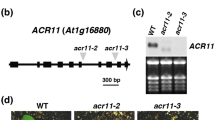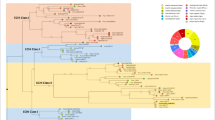Abstract
The Arabidopsis AtAHL gene encodes a 3′(2′),5′-bisphosphate nucleotidase that catalyzes the conversion of adenosine 3′,5′-bisphosphate (PAP) into adenosine monophosphate and inorganic phosphate. We have generated transgenic Arabidopsis overexpressing this gene under control of the cauliflower mosaic virus 35S (CaMV 35S) promoter. Transgenic lines integrating a single copy of the insert DNA and constitutively expressing the AtAHL gene were selected. The transgenic lines of Arabidopsis plants exhibited enhanced resistance to Pectobacterium carotovorum subsp. carotovorum. In general, plant defense responses and sulfur metabolism are linked through jasmonic acid signaling. The expression of sulfur-related defense genes is known to be induced via a jasmonate-mediated signaling pathway. In this work, we observed that the expression of AtAHL was also induced by jasmonate treatment in Arabidopsis. Our data suggest that PAP catabolic activity enhanced by the jasmonate signaling pathway contributes to the rapid flux of the sulfur activation pathway, accelerates the incorporation of activated sulfur into sulfur-containing defense molecules such as defensins, thionins, and glucosinolates, and thereby increases defense resistance in plants.
Similar content being viewed by others
References
Aguilar I, Alamillo JM, García-Olmedo F, and Rodríguez-Palenzuela P (2002) Natural variability in the Arabidopsis response to infection with Erwinia carotovora subsp. carotovora. Planta 215, 205–209.
Brader G, Mikkelsen MD, Halkier BA, and Palva ET (2006) Altering glucosinolate profiles modulates disease resistance in plants. Plant J 46, 758–767.
Brader G, Tas E, and Palva ET (2001) Jasmonate-dependent induction of indole glucosinolates in Arabidopsis by culture filtrates of the nonspecific pathogen Erwinia carotovora. Plant Physiol 126, 849–860.
Broekaert WF, Terras FRG, Cammue BPA, and Osborn RW (1995) Plant defensins: Novel antimicrobial peptides as components of the host defense system. Plant Physiol 108, 1353–1358.
Carpenter CD and Simon AE (1998) Preparation of RNA. Methods Mol Biol 82, 85–89.
Cheong J-J and Kwon H-B (1999) Arabidopsis AtAHL gene encodes a 3′(2′),5-bisphosphate nucleotidase sensitive to toxic heavy metal ions. Agric Chem Biotechnol 42, 169–174.
Clough SJ and Bent AF (1998) Floral dip; a simplified method for Agrobacterium-mediated transformation of Arabidopsis thaliana. Plant J 16, 735–743.
Cooper RM and Williams JS (2004) Elemental sulfur as an induced antifungal substance in plant defence. J Exp Bot 55, 1947–1953.
Dichtl B, Stevens A, and Tollervey D (1997) Lithium toxicity in yeast is due to the inhibition of RNA processing enzymes. EMBO J 16, 7184–7195.
Droux M (2004) Sulfur assimilation and the role of sulfur in plant metabolism: a survey. Photosynth Res 79, 331–348.
Epple P, Apel K, and Bohlmann H (1997) Overexpression of an endogenous thionin enhances resistance of Arabidopsis against Fusarium oxysporum. Plant Cell 9, 509–520.
Falk KL, Tokuhisa JG, and Gershenzon (2007) The effect of sulfur nutrition on plant glucosinolate content: physiology and molecular mechanisms. Plant Biol 9, 573–581.
Gil-Mascarell R, López-Coronado JM, Bellés JM, Serrano R, and Rodríguez PL (1999) The Arabidopsis HAL2-like gene family includes a novel sodium-sensitive phosphatase. Plant J 17, 373–383.
Halkier BA and Gerschenzon J (2006) Biology and biochemistry of glucosinolates. Annu Rev Plant Biol 57, 303–333.
Hell R (1997) Molecular physiology of plant sulfur metabolism. Planta 202, 138–148.
Jost R, Altschmied L, Bloem E, Bogs J, Gershenzon J, Hähnel U et al. (2005) Expression profiling of metabolic genes in response to methyl jasmonate reveals regulation of genes of primary and secondary sulfur-related pathways in Arabidopsis thaliana. Photosynth Res 86, 491–508.
Jung C, Lyou SH, Yeu SY, Kim MA, Rhee S, Kim M et al. (2007) Microarray-based screening of jasmonate-responsive genes in Arabidopsis thaliana. Plant Cell Report 26, 1053–1063.
Klaassen CD and Boles JW (1997) The importance of 3′-phosphoadenosine 5′-phosphosulfate (PAPS) in the regulation of sulfation. FASEB J 11, 404–418.
Kopriva S (2006) Regulation of sulfate assimilation in Arabidopsis and beyond. Ann Bot 97, 479–495.
Kopriva S and Koprivova A (2004) Plant adenosine 5′-phosphosulphate reductase: the past, the present, and the future. J Exp Bot 55, 1775–1783.
Kopriva S, Fritzemeier K, Wiedemann G, and Reski R (2007) The Putative moss 3-phosphoadenosine-5-phosphosulfate reductase is a novel form of adenosine-5-phosphosulfate reductase without an iron-sulfur cluster. J Biol Chem 282, 22930–22938.
Koprivova A, Meyers AJ, Schween G, Herschbach C, Reski R, and Kopriva S (2002) Functional knockout of the adenosine 5′-phosphosulfate reductase gene in Physcomitrella patens revives an old rout of sulfate assimilation. J Biol Chem 277, 32195–32201.
Kruse C, Jost R, Lipschis M, Kopp B, Hartmann, and Hell R (2007) Sulfurenhanced defence: effects of sulfur metabolism, nitrogen supply, and pathogen lifestyle. Plant Biol 9, 608–619.
Leyh TS (1993) The physical biochemistry and molecular genetics of sulfate activation. Crit Rev Biochem Mol Biol 28, 515–542.
Murguía JR, Bellés JM, and Serrano R (1996) The yeast HAL2 nucleotidase is an in vivo target of salt toxicity. J Biol Chem 271, 29029–29033.
Peng Z and Verma DP (1995) A rice HAL2-like gene encodes a Ca2+-sensitive 3′(2′)-phosphohydrolase and complements yeast met22 and Escherichia coli cysQ mutations. J Biol Chem 270, 29105–29110.
Perombelon MCM and Kelman A (1980) Ecology of the soft rot Erwinias. Annu Rev Phytopathol 18, 361–387.
Quintero FJ, Garciadeblas B, and Rodriguez-Navarro A (1996) The SAL1 gene of Arabidopsis, encoding an enzyme with 3′(2′),5′-bisphosphate nucleotidase and inositol polyphosphate 1-phosphatase activities, increases salt tolerance in yeast. Plant Cell 8, 529–537.
Rausch T and Wachter A (2005) Sulfur metabolism: a versatile platform for launching defence operations. Trends Plant Sci 10, 503–509.
Rodríguez VM, Chetelat A, Majcherczyk P, and Farmer EE (2010) Chloroplastic phosphoadenosine phosphosulfate metabolism regulates basal levels of the prohormone jasmonic acid in Arabidopsis leaves. Plant Physiol 152, 1335–1345.
Rojo E, León J, and Sánchez-Serrano JJ (1999) Cross-talk between wound signaling pathways determines local versus systemic gene expression in Arabidopsis thaliana. Plant J 20, 135–142.
Sasaki-sekimoto Y, Taki N, Obayashi T, Aono M, Matsumoto F, Sakurai N et al. (2005) Coordinated activation of metabolic pathways for antioxidants and defence compounds by jasmonates and their roles in stress tolerance in Arabidopsis. Plant J 44, 653–668.
Sønderby IE, Geu-Flores F, and Halkier BA (2010) Biosynthesis of glucosinolates — gene discovery and beyond. Trends Plant Sci 15, 283–290.
Takahashi H, Kopriva S, Giordano M, Saito K, and Hell R (2011) Sulfur Assimilation in Photosynthetic Organisms: Molecular Functions and Regulations of Transporters and Assimilatory Enzymes. Annul Rev Plant Biol 62, 157–184.
Thomma BPHJ, Cammue BPA, and Thevissen K (2002) Plant defensins. Planta 216, 193–202.
Yang L-M, Fernandez MD, and Lamppa GK (1994) Acyl carrier protein (ACP) import into chloroplasts: Covalent modification by a stromal holo ACP synthase is stimulated by exogenously added CoA and inhibited by adenosine 3′,5′-bisphosphate. Eur J Biochem 224, 743–750.
Author information
Authors and Affiliations
Corresponding author
Rights and permissions
About this article
Cite this article
Park, H.J., Choi, Y.D., Song, S.I. et al. Overexpression of the 3′(2′),5′-bisphosphate nucleotidase gene AtAHL confers enhanced resistance to Pectobacterium carotovorum in Arabidopsis . J Korean Soc Appl Biol Chem 56, 21–26 (2013). https://doi.org/10.1007/s13765-012-2178-2
Received:
Accepted:
Published:
Issue Date:
DOI: https://doi.org/10.1007/s13765-012-2178-2




